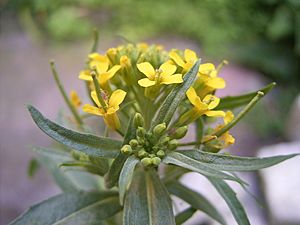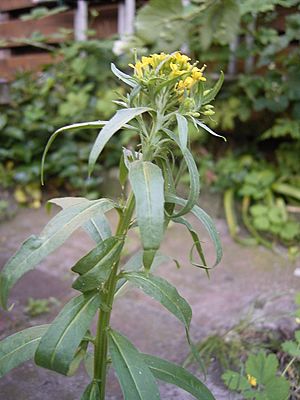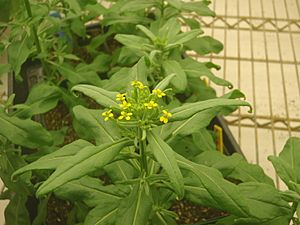Treacle-mustard facts for kids
Quick facts for kids Treacle-mustard |
|
|---|---|
 |
|
| Scientific classification | |
| Genus: |
Erysimum
|
| Species: |
cheiranthoides
|
| Synonyms | |
|
Cheirinia cheiranthoides |
|
Erysimum cheiranthoides, often called the treacle-mustard, wormseed wallflower, or wormseed mustard, is a type of plant. It grows naturally across much of central and northern Europe and northern and central Asia. Like other plants in its group, Erysimum cheiranthoides makes special chemicals. These chemicals, called glucosinolates and cardiac glycosides, help protect it from things that might try to eat it.
Contents
What Does Treacle-Mustard Look Like?
This plant is a herbaceous (meaning it has soft stems, not woody ones) and an annual plant. This means it completes its whole life cycle in one year. It looks a lot like other mustard plants. It grows a straight stem that can be anywhere from 15 to 100 centimeters (about 6 to 39 inches) tall. Sometimes, it can even reach 150 cm (about 59 inches).
Its leaves are shaped like a spear or an oval. They are usually 2 to 11 cm (about 0.8 to 4.3 inches) long and 0.5 to 1 cm (about 0.2 to 0.4 inches) wide. The edges of the leaves can be smooth or have rough teeth.
Flowers and Seeds
The treacle-mustard blooms in the summer, usually between June and August. Its flowers are bright yellow and small, about 5 to 12 millimeters (0.2 to 0.5 inches) across. They grow in a tall, upright cluster. After the flowers, the plant makes thin, tube-shaped seed pods called capsules. These pods are 1 to 3 cm (0.4 to 1.2 inches) long, but can sometimes be up to 5 cm (2 inches). Inside, they hold many small, light or dark brown seeds.
Plant Name and History
The famous Swedish botanist Carl Linnaeus first described this plant. He wrote about it in his important book 'Species Plantarum' in 1753.
Why Is It Called Treacle-Mustard?
The name "treacle-mustard" comes from an old Greek word, 'theriaki'. This word means "antidote to poisonous bites." People once thought the plant had healing powers. The name "wormseed mustard" came about because the plant's seeds were used to make a syrup, like treacle. This syrup was given to children to treat intestinal worms.
Where Does Treacle-Mustard Grow?
Erysimum cheiranthoides is a native plant in temperate areas of both Europe and Asia. This means it naturally grows there.
Global Distribution
You can find it in many parts of Asia, including China (in provinces like Heilongjiang and Xinjiang), Japan, Korea, Mongolia, and Siberia. In Eastern Europe, it grows in countries like Belarus and Ukraine. In Central Europe, it's found in places such as Germany and Poland. It also grows in Northern Europe, including Finland and the United Kingdom. In Southeastern Europe, you can find it in countries like Bulgaria and France.
This plant has also spread and become naturalised in many places outside its original home. This includes New Zealand, other parts of Europe, and North America. It even grows in parts of Canada and Argentina.
Where Does Treacle-Mustard Live?
Treacle-mustard likes to grow in places where the ground has been disturbed. You can find it in fields and dry stream beds. It usually grows at altitudes from sea level up to 3,000 meters (about 9,800 feet) high.
How Does Treacle-Mustard Protect Itself?
Like other plants in the Erysimum group, treacle-mustard has special ways to defend itself. It makes two main types of chemicals to stop animals from eating it. One type is called glucosinolates, which are common in the Brassicaceae plant family (like cabbage). The other type is cardiac glycosides, also known as cardenolides. These chemicals are made by at least twelve different plant families.
Plant Defenses and Insects
Some insects that usually eat plants in the mustard family do not like E. cheiranthoides. For example, the orange tip butterfly usually lays its eggs on almost all mustard plants. However, it avoids treacle-mustard. The white cabbage butterfly also tries not to eat or lay eggs on this plant.
But not all insects are bothered by these chemicals. Another type of butterfly, the green-veined white butterfly, is less sensitive to the plant's chemicals. It actually lays its eggs more easily on E. cheiranthoides leaves. Scientists have found that some chemicals in the plant attract the white cabbage butterfly, while others push it away.
Why Is Treacle-Mustard Important for Science?
Erysimum plants are in the same family as Arabidopsis thaliana. Arabidopsis is a very well-studied plant that scientists use a lot in genetic research. Because they are related, scientists can use much of the information and tools from Arabidopsis to study Erysimum. This makes E. cheiranthoides a great plant for learning how plants make cardenolides.
A Good Plant for Lab Studies
E. cheiranthoides is a diploid plant, meaning it has two sets of chromosomes. It has a fairly small genome (all its genetic material) with about 200 million base pairs spread across 8 chromosomes. It grows quickly, going from a seed to making new seeds in as little as 10 weeks. This makes it easy to study in a lab. Scientists have even mapped out the genome of one type of E. cheiranthoides. Since it's so similar to Arabidopsis thaliana, many ways of changing Arabidopsis' genes might also work for E. cheiranthoides. Scientists have already found types of E. cheiranthoides that have different amounts of cardiac glycosides.
Medicinal Uses of Treacle-Mustard
The cardiac glycosides found in E. cheiranthoides have been used in medicine for a long time. They can help treat heart disease and other health problems. However, treacle-mustard is not a common source for these medicines today.
Traditional Remedies
Even so, E. cheiranthoides has been used as a herbal remedy in traditional Chinese medicine. In the 16th century, European herbalists used the plant to treat bites from insects and animals. The common name "wormseed wallflower" comes from its historical use in treating intestinal worms.
See also
 In Spanish: Erysimum cheiranthoides para niños
In Spanish: Erysimum cheiranthoides para niños



